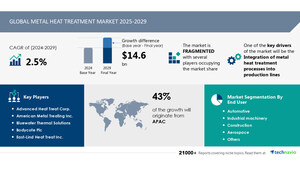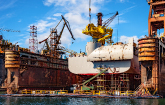NEW YORK, July 4, 2024 /PRNewswire/ -- The global barge transportation market size is estimated to grow by USD 38.3 billion from 2024-2028, according to Technavio. The market is estimated to grow at a CAGR of 5.39% during the forecast period. Rising crude oil movement by barges is driving market growth, with a trend towards growth opportunities in petrochemical industries. However, high entry barrier in barge transportation market poses a challenge. Key market players include Alter Logistics Co., American Commercial Barge Line LLC, Argosy International Inc., Blessey Marine Services Inc., Danser Group, Dubbelman Container Transporten BV, Ergon Inc., Haeger and Schmidt Logistics GmbH, Heartland Barge Management LLC, Ingram Marine Group, Kirby Corp., Livingston International Inc., Marquette Transportation Co. LLC, McAllister Towing and Transportation Co. Inc., neska Container Line BV, Poh Tiong Choon Logistics Ltd., SEACOR Holdings Inc., Singa KBH Industry Sdn Bhd, The Greenbrier Companies Inc., and Waalhaven Holding BV.
Get a detailed analysis on regions, market segments, customer landscape, and companies - Click for the snapshot of this report
Forecast period |
2024-2028 |
Base Year |
2023 |
Historic Data |
2018 - 2022 |
Segment Covered |
Type (Dry cargo barge and Liquid cargo barge), Application (Agricultural products, Coal and crude petroleum, Food and beverage, and Others), and Geography (APAC, North America, Europe, South America, and Middle East and Africa) |
Region Covered |
APAC, North America, Europe, South America, and Middle East and Africa |
Key companies profiled |
Alter Logistics Co., American Commercial Barge Line LLC, Argosy International Inc., Blessey Marine Services Inc., Danser Group, Dubbelman Container Transporten BV, Ergon Inc., Haeger and Schmidt Logistics GmbH, Heartland Barge Management LLC, Ingram Marine Group, Kirby Corp., Livingston International Inc., Marquette Transportation Co. LLC, McAllister Towing and Transportation Co. Inc., neska Container Line BV, Poh Tiong Choon Logistics Ltd., SEACOR Holdings Inc., Singa KBH Industry Sdn Bhd, The Greenbrier Companies Inc., and Waalhaven Holding BV |
Key Market Trends Fueling Growth
The US barge transportation market is set to expand due to the rising demand for petrochemical shipments within the country. The petrochemical sector's reliance on marine transportation, particularly barges, is a significant factor fueling this growth. The agricultural industry, which has extensive access to the inland waterway system, also contributes to the demand for barges for transporting farm products like agricultural chemicals. The global petrochemicals market's expansion, driven by the construction, automobile, and packaging industries, further boosts the barge transportation market. In 2022, petrochemical companies increased their production capacity in the US Gulf Coast by over 2397.09 million tons. These new plants, operational during the forecast period, will necessitate the use of barges for transporting petrochemicals, creating lucrative opportunities for barge transportation service providers. As a result, the petrochemical industry's growth trends are a major driver for the global barge transportation market's growth during the forecast period.
The barge transportation market is experiencing significant growth due to the development of waterway infrastructure, making waterways an attractive alternative to traditional road and rail transport. With urban traffic congestion increasing, streamlined logistics through waterways is becoming a popular solution for moving bulk cargo, such as grains, food products, and dry bulk cargo, over long distances. Manufacturing plants are also turning to barge transport services to move raw materials and finished products, including solar panels and eco-friendly solutions like zero-emission barges, e-barges, and e-pushers. Cargo volumes are increasing, particularly in sectors like cocoa beans and chemicals. Travel restrictions and crew mobility challenges are being addressed through innovative vessel operations. The market is also seeing a shift towards carbon neutrality, with a focus on using renewable energy sources and reducing emissions from vessels. Waterway networks, including rivers and canals, are being expanded to accommodate larger vessels carrying a variety of specialized goods, from crude oils and metal ores to liquid cargo and finished products.
Research report provides comprehensive data on impact of trend. For more details- Download a Sample Report
Market Challenges
- The barge transportation market is characterized by significant capital investments for barge line operators. The Jones Act, a US protectionist policy, increases the cost of US-built barges, which are approximately four times more expensive than foreign-built ones. Ongoing expenses, such as upgrading, cleaning, crew wages, and docking charges, add to the high maintenance costs. These factors contribute to the high entry barrier in the US market, making it challenging for global barge transportation market growth during the forecast period. US citizens must own and build barges under the Jones Act, limiting foreign competition in the US marine transportation industry.
- Barge transportation plays a crucial role in moving bulk cargo across various water bodies. However, the industry faces several challenges. Designing efficient barges that can navigate through dams and other obstacles is a significant hurdle. Propulsion systems require continuous improvement to enhance transportation capacity. Green logistics initiatives are essential to reduce carbon footprint and comply with regulations. Navigable rivers and water bodies serve as transportation routes, but dams and other infrastructure can limit access. Industry expertise and supportive policies are vital to overcome these challenges. Regulations regarding safety and security are crucial, with concerns over unauthorized access, theft, and tampering. The dry cargo segment, including grain, aggregates, and construction materials, dominates the market. Coal, ores, and agricultural products are common cargos. Security benefits make barge transportation an attractive option for industries like manufacturing and transportation of sensitive goods like nuclear fuel, beverages, tobacco, and fabricated metal products. Modernization of barge fleet, including open barges, covered barges, and tank barges, is essential to meet evolving demand. Intracoastal and inland water transportation play a significant role in the industry. Dredging operations are necessary to maintain transportation capacity. Application segments include agricultural products, rubber and plastic, and various industries like nuclear fuel, beverages, tobacco, and fabricated metal products.
For more insights on driver and challenges - Download a Sample Report
Segment Overview
This barge transportation market report extensively covers market segmentation by
- Type
- 1.1 Dry cargo barge
- 1.2 Liquid cargo barge
- Application
- 2.1 Agricultural products
- 2.2 Coal and crude petroleum
- 2.3 Food and beverage
- 2.4 Others
- Geography
- 3.1 APAC
- 3.2 North America
- 3.3 Europe
- 3.4 South America
- 3.5 Middle East and Africa
1.1 Dry cargo barge- The global barge transportation market for dry cargo is projected to expand during the forecast period. The primary driver for this growth is the increasing dry cargo capacity worldwide. The demand for leased dry containers will increase due to the expanding agriculture sector and the production of electronic goods, home appliances, textiles, and other bulk materials in countries like China, India, Australia, Russia, the US, Mexico, South Africa, and Brazil. These nations, with large populations and high demand for commodities such as agricultural products, electronic goods, textiles, and nonperishable items, will fuel the growth of the dry container segment in the barge transportation market. In 2022, China, India, the US, and Brazil were significant producers, consumers, and importers of food products, with a focus on nonperishable agricultural produce like wheat, which is transported using dry containers. As a result, the growth in the production of wheat and other nonperishable products will propel the dry containers segment of the global barge transportation market forward during the forecast period. (Word count: 98)
For more information on market segmentation with geographical analysis including forecast (2024-2028) and historic data (2018 - 2022) - Download a Sample Report
Research Analysis
The barge transportation market encompasses the use of boats and large vessels for moving goods on inland waterways, including rivers and canals. This mode of transport is particularly popular for bulk cargo, such as dry bulk commodities like grains and coal, as well as liquid cargo like oil and chemicals. Barges are flat-bottomed vessels, making them ideal for navigating shallow waterways and intercoastal routes. Inland waterway transportation is a crucial component of the shipping industry, offering streamlined logistics and reducing urban traffic congestion. Regional waterway infrastructure plays a significant role in the market's growth, with ongoing modernization and dredging operations to accommodate larger vessels and increased cargo volumes. Inland waterways transport is an essential alternative to traditional trucking and rail transportation for oversized loads and bulk commodities.
Market Research Overview
Barge transportation is an essential mode of cargo freight, particularly for bulk goods such as grains, food products, metal ores, crude oils, chemicals, and minerals. It utilizes large vessels, including flat-bottomed boats and shallow-draft vessels, to transport goods through inland waterways, rivers, and canals. This carbon-neutral option reduces the need for road freight transportation and helps decrease carbon footprints. However, it faces challenges such as accidents, fatalities, and fuel consumption. Tugboats tow large ocean-going barges, while barracks and liquid cargo barges carry crew members and cargo materials, respectively. Split hopper barges facilitate the transportation of dry bulk cargo, while conveyor belts and port infrastructure streamline the loading and unloading process. Seaports and river projects are key areas of investment for the barge transportation market, with seaport expansions and trade driving growth. The industry faces competition from rail, trucks, pipelines, and modal shift initiatives, necessitating innovative barge design, propulsion systems, and green logistics initiatives. Navigational channels, locks, and weather conditions also impact the efficiency and safety of barge transportation.
Table of Contents:
1 Executive Summary
2 Market Landscape
3 Market Sizing
4 Historic Market Size
5 Five Forces Analysis
6 Market Segmentation
- Type
- Dry Cargo Barge
- Liquid Cargo Barge
- Application
- Agricultural Products
- Coal And Crude Petroleum
- Food And Beverage
- Others
- Geography
- APAC
- North America
- Europe
- South America
- Middle East And Africa
7 Customer Landscape
8 Geographic Landscape
9 Drivers, Challenges, and Trends
10 Company Landscape
11 Company Analysis
12 Appendix
About Technavio
Technavio is a leading global technology research and advisory company. Their research and analysis focuses on emerging market trends and provides actionable insights to help businesses identify market opportunities and develop effective strategies to optimize their market positions.
With over 500 specialized analysts, Technavio's report library consists of more than 17,000 reports and counting, covering 800 technologies, spanning across 50 countries. Their client base consists of enterprises of all sizes, including more than 100 Fortune 500 companies. This growing client base relies on Technavio's comprehensive coverage, extensive research, and actionable market insights to identify opportunities in existing and potential markets and assess their competitive positions within changing market scenarios.
Contacts
Technavio Research
Jesse Maida
Media & Marketing Executive
US: +1 844 364 1100
UK: +44 203 893 3200
Email: [email protected]
Website: www.technavio.com/
SOURCE Technavio

WANT YOUR COMPANY'S NEWS FEATURED ON PRNEWSWIRE.COM?
Newsrooms &
Influencers
Digital Media
Outlets
Journalists
Opted In





Share this article